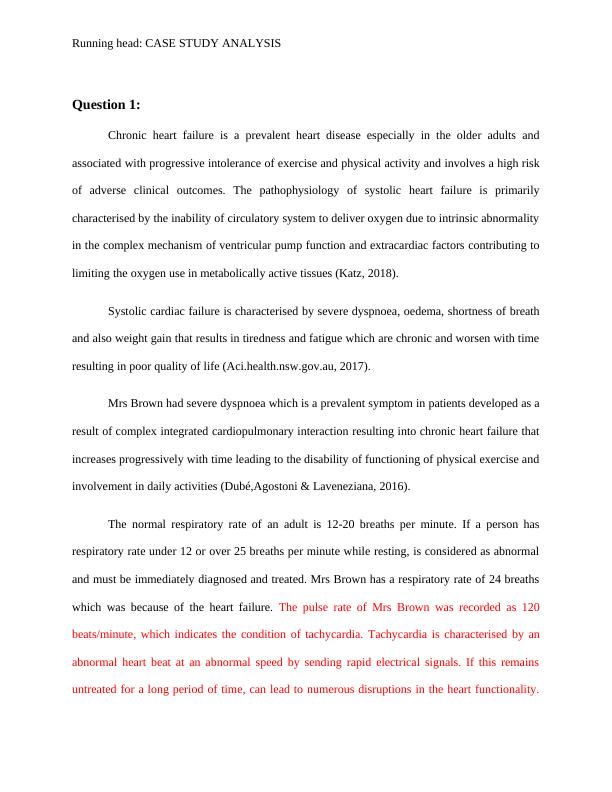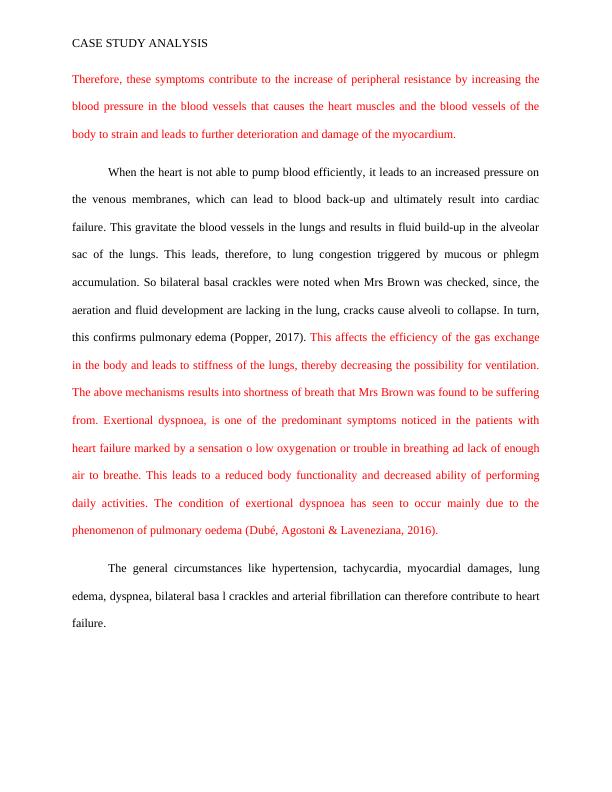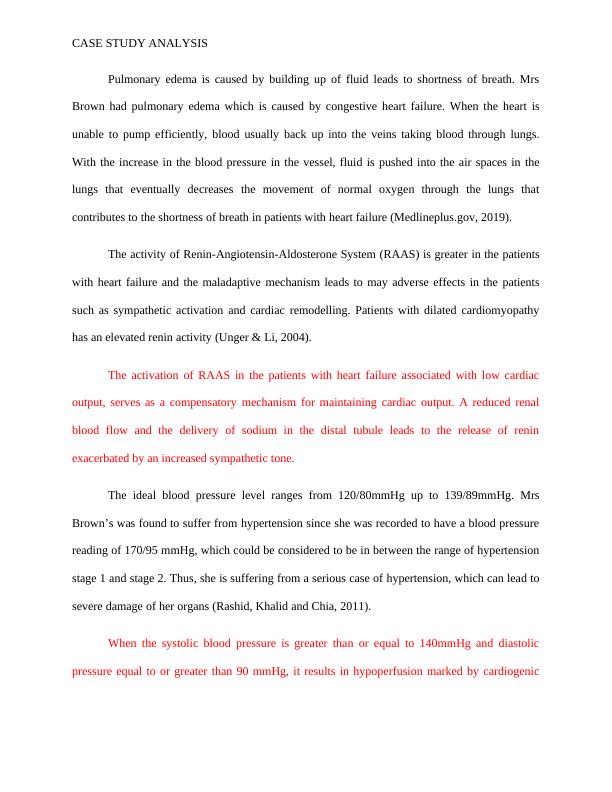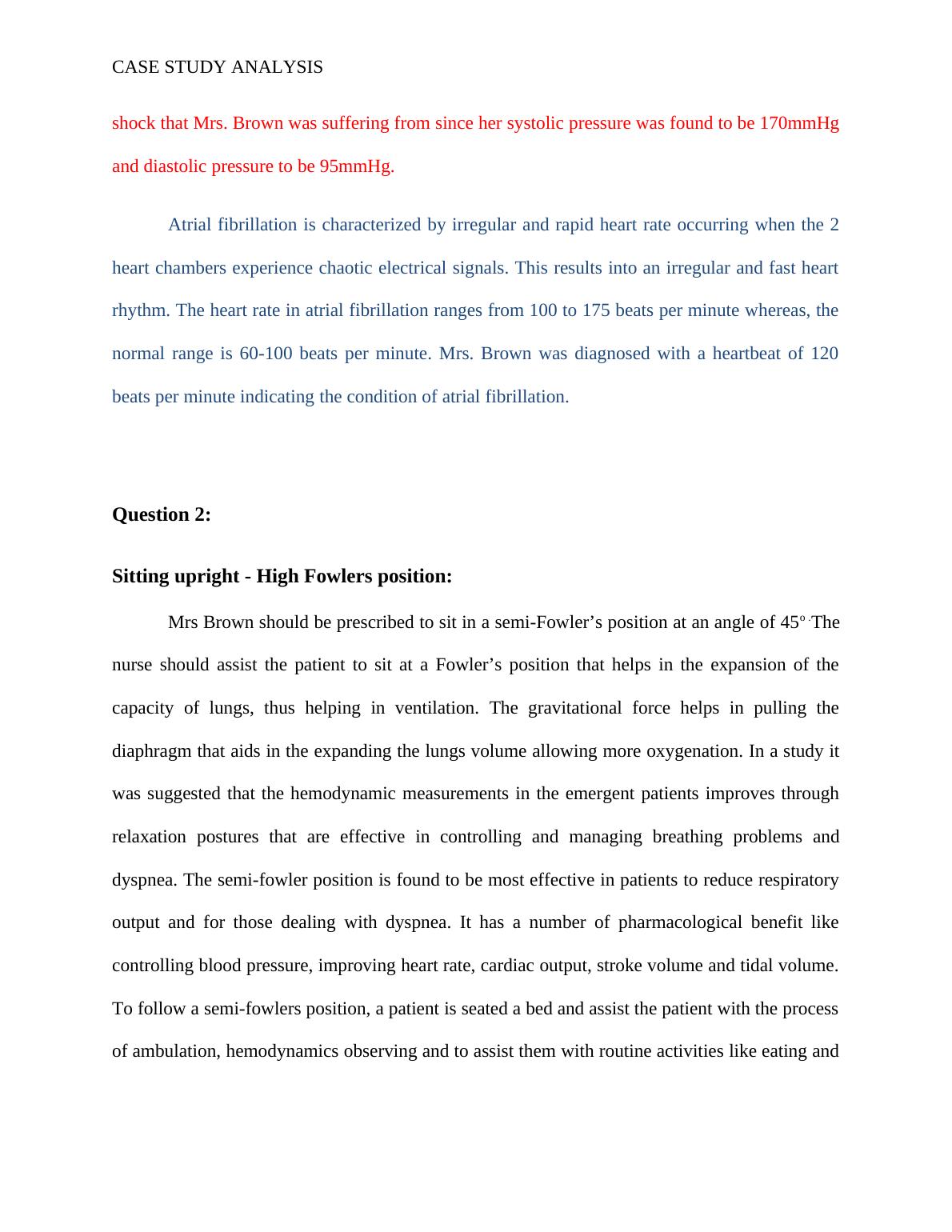Assignment on case study Analysis | Report
This assignment is about systolic heart failure, with a concept map and 3 questions.
11 Pages2749 Words17 Views
Added on 2022-10-04
Assignment on case study Analysis | Report
This assignment is about systolic heart failure, with a concept map and 3 questions.
Added on 2022-10-04
ShareRelated Documents
Running head: CASE STUDY ANALYSIS
Question 1:
Chronic heart failure is a prevalent heart disease especially in the older adults and
associated with progressive intolerance of exercise and physical activity and involves a high risk
of adverse clinical outcomes. The pathophysiology of systolic heart failure is primarily
characterised by the inability of circulatory system to deliver oxygen due to intrinsic abnormality
in the complex mechanism of ventricular pump function and extracardiac factors contributing to
limiting the oxygen use in metabolically active tissues (Katz, 2018).
Systolic cardiac failure is characterised by severe dyspnoea, oedema, shortness of breath
and also weight gain that results in tiredness and fatigue which are chronic and worsen with time
resulting in poor quality of life (Aci.health.nsw.gov.au, 2017).
Mrs Brown had severe dyspnoea which is a prevalent symptom in patients developed as a
result of complex integrated cardiopulmonary interaction resulting into chronic heart failure that
increases progressively with time leading to the disability of functioning of physical exercise and
involvement in daily activities (Dubé,Agostoni & Laveneziana, 2016).
The normal respiratory rate of an adult is 12-20 breaths per minute. If a person has
respiratory rate under 12 or over 25 breaths per minute while resting, is considered as abnormal
and must be immediately diagnosed and treated. Mrs Brown has a respiratory rate of 24 breaths
which was because of the heart failure. The pulse rate of Mrs Brown was recorded as 120
beats/minute, which indicates the condition of tachycardia. Tachycardia is characterised by an
abnormal heart beat at an abnormal speed by sending rapid electrical signals. If this remains
untreated for a long period of time, can lead to numerous disruptions in the heart functionality.
Question 1:
Chronic heart failure is a prevalent heart disease especially in the older adults and
associated with progressive intolerance of exercise and physical activity and involves a high risk
of adverse clinical outcomes. The pathophysiology of systolic heart failure is primarily
characterised by the inability of circulatory system to deliver oxygen due to intrinsic abnormality
in the complex mechanism of ventricular pump function and extracardiac factors contributing to
limiting the oxygen use in metabolically active tissues (Katz, 2018).
Systolic cardiac failure is characterised by severe dyspnoea, oedema, shortness of breath
and also weight gain that results in tiredness and fatigue which are chronic and worsen with time
resulting in poor quality of life (Aci.health.nsw.gov.au, 2017).
Mrs Brown had severe dyspnoea which is a prevalent symptom in patients developed as a
result of complex integrated cardiopulmonary interaction resulting into chronic heart failure that
increases progressively with time leading to the disability of functioning of physical exercise and
involvement in daily activities (Dubé,Agostoni & Laveneziana, 2016).
The normal respiratory rate of an adult is 12-20 breaths per minute. If a person has
respiratory rate under 12 or over 25 breaths per minute while resting, is considered as abnormal
and must be immediately diagnosed and treated. Mrs Brown has a respiratory rate of 24 breaths
which was because of the heart failure. The pulse rate of Mrs Brown was recorded as 120
beats/minute, which indicates the condition of tachycardia. Tachycardia is characterised by an
abnormal heart beat at an abnormal speed by sending rapid electrical signals. If this remains
untreated for a long period of time, can lead to numerous disruptions in the heart functionality.

CASE STUDY ANALYSIS
Therefore, these symptoms contribute to the increase of peripheral resistance by increasing the
blood pressure in the blood vessels that causes the heart muscles and the blood vessels of the
body to strain and leads to further deterioration and damage of the myocardium.
When the heart is not able to pump blood efficiently, it leads to an increased pressure on
the venous membranes, which can lead to blood back-up and ultimately result into cardiac
failure. This gravitate the blood vessels in the lungs and results in fluid build-up in the alveolar
sac of the lungs. This leads, therefore, to lung congestion triggered by mucous or phlegm
accumulation. So bilateral basal crackles were noted when Mrs Brown was checked, since, the
aeration and fluid development are lacking in the lung, cracks cause alveoli to collapse. In turn,
this confirms pulmonary edema (Popper, 2017). This affects the efficiency of the gas exchange
in the body and leads to stiffness of the lungs, thereby decreasing the possibility for ventilation.
The above mechanisms results into shortness of breath that Mrs Brown was found to be suffering
from. Exertional dyspnoea, is one of the predominant symptoms noticed in the patients with
heart failure marked by a sensation o low oxygenation or trouble in breathing ad lack of enough
air to breathe. This leads to a reduced body functionality and decreased ability of performing
daily activities. The condition of exertional dyspnoea has seen to occur mainly due to the
phenomenon of pulmonary oedema (Dubé, Agostoni & Laveneziana, 2016).
The general circumstances like hypertension, tachycardia, myocardial damages, lung
edema, dyspnea, bilateral basa l crackles and arterial fibrillation can therefore contribute to heart
failure.
Therefore, these symptoms contribute to the increase of peripheral resistance by increasing the
blood pressure in the blood vessels that causes the heart muscles and the blood vessels of the
body to strain and leads to further deterioration and damage of the myocardium.
When the heart is not able to pump blood efficiently, it leads to an increased pressure on
the venous membranes, which can lead to blood back-up and ultimately result into cardiac
failure. This gravitate the blood vessels in the lungs and results in fluid build-up in the alveolar
sac of the lungs. This leads, therefore, to lung congestion triggered by mucous or phlegm
accumulation. So bilateral basal crackles were noted when Mrs Brown was checked, since, the
aeration and fluid development are lacking in the lung, cracks cause alveoli to collapse. In turn,
this confirms pulmonary edema (Popper, 2017). This affects the efficiency of the gas exchange
in the body and leads to stiffness of the lungs, thereby decreasing the possibility for ventilation.
The above mechanisms results into shortness of breath that Mrs Brown was found to be suffering
from. Exertional dyspnoea, is one of the predominant symptoms noticed in the patients with
heart failure marked by a sensation o low oxygenation or trouble in breathing ad lack of enough
air to breathe. This leads to a reduced body functionality and decreased ability of performing
daily activities. The condition of exertional dyspnoea has seen to occur mainly due to the
phenomenon of pulmonary oedema (Dubé, Agostoni & Laveneziana, 2016).
The general circumstances like hypertension, tachycardia, myocardial damages, lung
edema, dyspnea, bilateral basa l crackles and arterial fibrillation can therefore contribute to heart
failure.

CASE STUDY ANALYSIS
Pulmonary edema is caused by building up of fluid leads to shortness of breath. Mrs
Brown had pulmonary edema which is caused by congestive heart failure. When the heart is
unable to pump efficiently, blood usually back up into the veins taking blood through lungs.
With the increase in the blood pressure in the vessel, fluid is pushed into the air spaces in the
lungs that eventually decreases the movement of normal oxygen through the lungs that
contributes to the shortness of breath in patients with heart failure (Medlineplus.gov, 2019).
The activity of Renin-Angiotensin-Aldosterone System (RAAS) is greater in the patients
with heart failure and the maladaptive mechanism leads to may adverse effects in the patients
such as sympathetic activation and cardiac remodelling. Patients with dilated cardiomyopathy
has an elevated renin activity (Unger & Li, 2004).
The activation of RAAS in the patients with heart failure associated with low cardiac
output, serves as a compensatory mechanism for maintaining cardiac output. A reduced renal
blood flow and the delivery of sodium in the distal tubule leads to the release of renin
exacerbated by an increased sympathetic tone.
The ideal blood pressure level ranges from 120/80mmHg up to 139/89mmHg. Mrs
Brown’s was found to suffer from hypertension since she was recorded to have a blood pressure
reading of 170/95 mmHg, which could be considered to be in between the range of hypertension
stage 1 and stage 2. Thus, she is suffering from a serious case of hypertension, which can lead to
severe damage of her organs (Rashid, Khalid and Chia, 2011).
When the systolic blood pressure is greater than or equal to 140mmHg and diastolic
pressure equal to or greater than 90 mmHg, it results in hypoperfusion marked by cardiogenic
Pulmonary edema is caused by building up of fluid leads to shortness of breath. Mrs
Brown had pulmonary edema which is caused by congestive heart failure. When the heart is
unable to pump efficiently, blood usually back up into the veins taking blood through lungs.
With the increase in the blood pressure in the vessel, fluid is pushed into the air spaces in the
lungs that eventually decreases the movement of normal oxygen through the lungs that
contributes to the shortness of breath in patients with heart failure (Medlineplus.gov, 2019).
The activity of Renin-Angiotensin-Aldosterone System (RAAS) is greater in the patients
with heart failure and the maladaptive mechanism leads to may adverse effects in the patients
such as sympathetic activation and cardiac remodelling. Patients with dilated cardiomyopathy
has an elevated renin activity (Unger & Li, 2004).
The activation of RAAS in the patients with heart failure associated with low cardiac
output, serves as a compensatory mechanism for maintaining cardiac output. A reduced renal
blood flow and the delivery of sodium in the distal tubule leads to the release of renin
exacerbated by an increased sympathetic tone.
The ideal blood pressure level ranges from 120/80mmHg up to 139/89mmHg. Mrs
Brown’s was found to suffer from hypertension since she was recorded to have a blood pressure
reading of 170/95 mmHg, which could be considered to be in between the range of hypertension
stage 1 and stage 2. Thus, she is suffering from a serious case of hypertension, which can lead to
severe damage of her organs (Rashid, Khalid and Chia, 2011).
When the systolic blood pressure is greater than or equal to 140mmHg and diastolic
pressure equal to or greater than 90 mmHg, it results in hypoperfusion marked by cardiogenic

CASE STUDY ANALYSIS
shock that Mrs. Brown was suffering from since her systolic pressure was found to be 170mmHg
and diastolic pressure to be 95mmHg.
Atrial fibrillation is characterized by irregular and rapid heart rate occurring when the 2
heart chambers experience chaotic electrical signals. This results into an irregular and fast heart
rhythm. The heart rate in atrial fibrillation ranges from 100 to 175 beats per minute whereas, the
normal range is 60-100 beats per minute. Mrs. Brown was diagnosed with a heartbeat of 120
beats per minute indicating the condition of atrial fibrillation.
Question 2:
Sitting upright - High Fowlers position:
Mrs Brown should be prescribed to sit in a semi-Fowler’s position at an angle of 45o .The
nurse should assist the patient to sit at a Fowler’s position that helps in the expansion of the
capacity of lungs, thus helping in ventilation. The gravitational force helps in pulling the
diaphragm that aids in the expanding the lungs volume allowing more oxygenation. In a study it
was suggested that the hemodynamic measurements in the emergent patients improves through
relaxation postures that are effective in controlling and managing breathing problems and
dyspnea. The semi-fowler position is found to be most effective in patients to reduce respiratory
output and for those dealing with dyspnea. It has a number of pharmacological benefit like
controlling blood pressure, improving heart rate, cardiac output, stroke volume and tidal volume.
To follow a semi-fowlers position, a patient is seated a bed and assist the patient with the process
of ambulation, hemodynamics observing and to assist them with routine activities like eating and
shock that Mrs. Brown was suffering from since her systolic pressure was found to be 170mmHg
and diastolic pressure to be 95mmHg.
Atrial fibrillation is characterized by irregular and rapid heart rate occurring when the 2
heart chambers experience chaotic electrical signals. This results into an irregular and fast heart
rhythm. The heart rate in atrial fibrillation ranges from 100 to 175 beats per minute whereas, the
normal range is 60-100 beats per minute. Mrs. Brown was diagnosed with a heartbeat of 120
beats per minute indicating the condition of atrial fibrillation.
Question 2:
Sitting upright - High Fowlers position:
Mrs Brown should be prescribed to sit in a semi-Fowler’s position at an angle of 45o .The
nurse should assist the patient to sit at a Fowler’s position that helps in the expansion of the
capacity of lungs, thus helping in ventilation. The gravitational force helps in pulling the
diaphragm that aids in the expanding the lungs volume allowing more oxygenation. In a study it
was suggested that the hemodynamic measurements in the emergent patients improves through
relaxation postures that are effective in controlling and managing breathing problems and
dyspnea. The semi-fowler position is found to be most effective in patients to reduce respiratory
output and for those dealing with dyspnea. It has a number of pharmacological benefit like
controlling blood pressure, improving heart rate, cardiac output, stroke volume and tidal volume.
To follow a semi-fowlers position, a patient is seated a bed and assist the patient with the process
of ambulation, hemodynamics observing and to assist them with routine activities like eating and

End of preview
Want to access all the pages? Upload your documents or become a member.
Related Documents
Chronic Heart Failure Question and Answer 2022lg...
|10
|2569
|22
Systolic Heart Failure Answer 2022lg...
|10
|2149
|36
Chronic Systolic Heart Failure: Causes, Symptoms, and Treatmentlg...
|8
|2001
|221
The Health Variation Questions 2022lg...
|9
|2102
|16
Healthcare Case Study 2022lg...
|8
|1968
|12
Case Study on Pathogenesis of Clinical Manifestations, Nursing Strategies and Mechanism of Two Drugs for Heart Failure Patientlg...
|9
|2179
|269
